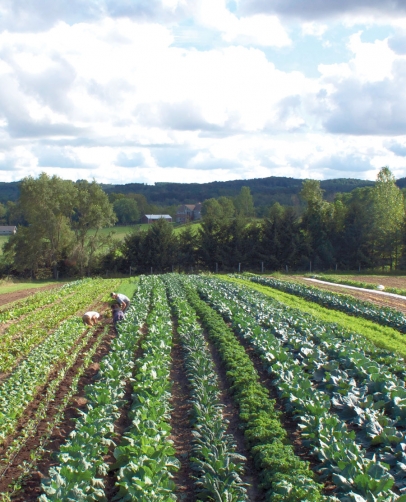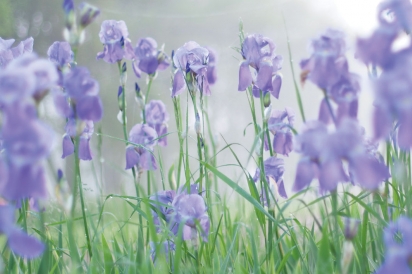Agristhetics: Farm Deco and the Cultivation of Beauty
An agricultural landscape is a human creation, and when approached with intention, can be a work of art. This is not referring to farm-inspired art like a pastoral painting or a Wendell Berry poem, but to the act of farming and the “scaped” land as the art itself.
This idea of farming as art, as far as I know has no title, whereas food and cooking when elevated to the status of art have the term gastronomy, and the field as a whole is titled the culinary arts. There is even an obscure label for the art of dining, aristology, as coined by the British food writer Thomas Walker in 1835. If we can artfully dine and artfully cook, we must be able to artfully cultivate the land, hence the birth of agristhetics and farm deco.
When a master is highly skilled in a craft we then call it an art. As in, “The builder has his work down to an art.” But does this mean that the finished home is the art or is it the work itself? It is common to see a farm as the subject of art, but a bit slippery to call farming itself an art. Paintings, photos and writing have for centuries used the farm and its produce as subjects of study, but if fruit, plants and landscape are all subjects of art, then it seems that the producer of the “work” is really the farmer. The art is created in production; it is the piece of fruit held in the hand, the rhythm of fieldwork and the shaped land, all else is facsimile or interpretation.
Like a sculpture the fields are conceptualized prior to creation. In winter the field layout and the cropping schedule are sketched and outlined. At first thaw the sculpting begins. It is the farmer’s duty, vowed in the marriage to the land, to sculpt gently and to follow contours.
A farm is no less a work of art than a sculpture is, but a farm is arguably a better display of the art of work. At a past incarnation of my own farming history we had neighbors who frequently told us how much they liked to watch us work, and if you can look beyond the creepy image of neighbors watching you from their windows, the point can be made that people like to watch the artful movement of work.
A writer learns to carefully read words, a painter learns to read light and a farmer learns to read the land. Like a palm reader, a land reader follows furrows and wrinkles and intersections, tracing the past and influencing the future. The land is written in Braille, raised dots and textures that must be felt to be understood. Reading the land requires crawling on hands and knees, it requires walking and watching, listening and tasting. Farming technique and skill are textbook studies, but the land must be learned through interaction and observation. Developing land literacy is what transforms a farmer from laborer to artist.
It is no coincidence that we see farms and food as objects of beauty, so much so that we create paintings of vegetables on linens, bowls of fake fruit on credenzas and tableaux of pumpkins and cornstalks on stoops. Decorations of food were once piles of necessity. The beauty is not only in the field and fruit—the physical objects—but also in the representation of abundance. It is also no coincidence that our condition fits into the natural order, and so it is that long-lasting fruits droop from autumn vines. We collect them in cool nooks of the house; piles of winter sustenance to carry us across the frozen plains. When on a country outing we consciously see rolling fields and woodlots, stone fences and red barns, but subconsciously we see survival and the production of our sustenance, and this is art at its core, a reflection on the essence of the human condition.
Agristhetics is not only the idea of the farm as a working art, but also the intersection of farming and traditional modes of art. The farmer is privy to subtleties in nature that few others experience. These subtleties and evasive moments are what the painter, photographer or writer tries to capture to carry them from the field to the city. A friend once remarked that he loves movies so much because they, in a strange way, reveal life to us better than our actual lives do. I think of that often when working in the fields. The light is always changing, one field is harvested while another is planted and the farm gets lost in the constant change unless it can be captured in frame or photo or words. From time to time as I work the fields a trace of inspiration floats by and I run through rows crossing the field up to the barn to fetch my camera or pencil and I grab for the moment. In this way the camera, pencil and brush are a farmer’s tools just like a hoe is. They are beauty harvesters and in some ways they can capture the farm better than the farm captures itself.
Food and farming is artwork consumed one moment and gone the next. A farmer, like a vintner or cook, combines elemental things into works of expressional sustenance. We purchase this art and ingest it and it is gone. The farm is particularly adept at the demonstration of perpetual un-lasting-ness. Good food and inspiring landscapes create anticipations of nostalgia—so good and sweet and momentary and gone.
Farms and food are manifestations of culture and their social omnipresence shape our landscape and decorate our kitchens and bodegas. Constantly in need of sustenance and always surrounded by our surroundings it is essential that we foster the bucolic in our land-scapes and our food-scapes. We are the art that we create. Elevating food and farming to the status of art displays the importance that we place on stewardship and systemic health as well as on the profession of the farmer.
Farming, like life, demands artful eyes for full appreciation. The most mundane of days when viewed as an undocumented work of art can be revelatory. This is not to say that each action in life needs to be framed in a photo or written of, but that when the pervasive mist that accompanies your day is open to beauty and feeling and thoughtfulness, life becomes not drudgery but endless opportunity to create.
ag·ri·sthe·tics
(noun)
The combination of agriculture and aesthetics conveying the duality of farming not for food alone, but also for beauty in landscape, produce and the act of work. Henry’s agristhetic was clean and linear.SYNONYM: farm deco








